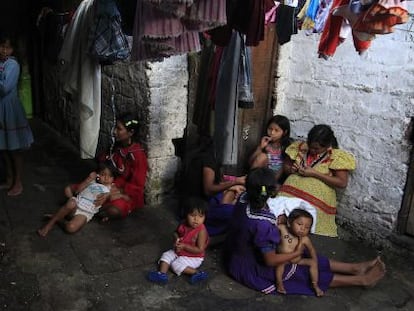More than 25 million Latin Americans face renewed threat of poverty
New report by the UN Development Programme warns that women and minorities are particularly vulnerable

A new report by the United Nations Development Programme (UNDP) says that 72 million Latin Americans left poverty behind from 2003 to 2013, earning between $4 and $10 a day. But the agency now warns that more than 25 million of them could now fall back into hardship if the right policies are not introduced.
Released on Tuesday, Multidimensional Progress: Well-being beyond income alerts to the risks posed by a combination of a lengthy economic crisis and social exclusion in the region.
According to the report, the main threat comes from social inequality. Women, indigenous groups and people of African descent are particularly vulnerable, as they continue to earn less than other groups despite making more than they used to. As such, the gap is not getting smaller, notes George Gray Molina, chief economist at UNPD for the region and the main author of the report.
The challenges of sustainable, holistic and universal development do not end at a certain income threshold
Jessica Faieta, UNPD official
¡°Women with more education are still earning 16.4% less than men. It¡¯s not about giving one group a higher income, it¡¯s about taking action against discrimination,¡± he explains.
Many Latin Americans suffer forms of discrimination that remain invisible to statistics and public policy action, notes the study. These ¡°multiple exclusions¡± based on ethnicity, race, skin color, sexual orientation, migratory status and disability cannot be resolved through higher incomes. Instead, they require ¡°affirmative action, anti-discrimination policies and the acknowledgment of collective rights.¡±
Less well than expected
The report acknowledges the progress made in Latin America and the Caribbean on indicators such as mortality during childbirth, child malnutrition and basic services such as electricity, water and sanitation.
Sign up for our newsletter
EL PA?S English Edition has launched a weekly newsletter. Sign up today to receive a selection of our best stories in your inbox every Saturday morning. For full details about how to subscribe, click here.
But it also warns that other indicators are showing levels that fall short of expectations, most notably homicide rates, income inequality, teenage pregnancies, precarious employment and school dropout rates.
The UNPD also underscores that the nearly 50 million people who joined the labor market during the 2003-2013 boom were mostly employed in the services sector as construction workers, hairdressers and waiters. But these jobs are tied to consumption, not investment, and when consumption goes down, these positions disappear.
Because of these shortcomings, 25 to 30 million Latin Americans risk slipping back into poverty, representing one out of every three who were lifted out of it between 2003 and 2013.
¡°The challenges of sustainable, holistic and universal development do not end at a certain income threshold: we don¡¯t ¡®graduate¡¯ from development challenges unless we can respond accordingly to the multiple dimensions that enable people to live the lives they consider valuable,¡± said United Nations Assistant Secretary-General and UNDP Regional Director for Latin America and the Caribbean, Jessica Faieta, at the report launch.
English version by Susana Urra.
Tu suscripci¨®n se est¨¢ usando en otro dispositivo
?Quieres a?adir otro usuario a tu suscripci¨®n?
Si contin¨²as leyendo en este dispositivo, no se podr¨¢ leer en el otro.
FlechaTu suscripci¨®n se est¨¢ usando en otro dispositivo y solo puedes acceder a EL PA?S desde un dispositivo a la vez.
Si quieres compartir tu cuenta, cambia tu suscripci¨®n a la modalidad Premium, as¨ª podr¨¢s a?adir otro usuario. Cada uno acceder¨¢ con su propia cuenta de email, lo que os permitir¨¢ personalizar vuestra experiencia en EL PA?S.
?Tienes una suscripci¨®n de empresa? Accede aqu¨ª para contratar m¨¢s cuentas.
En el caso de no saber qui¨¦n est¨¢ usando tu cuenta, te recomendamos cambiar tu contrase?a aqu¨ª.
Si decides continuar compartiendo tu cuenta, este mensaje se mostrar¨¢ en tu dispositivo y en el de la otra persona que est¨¢ usando tu cuenta de forma indefinida, afectando a tu experiencia de lectura. Puedes consultar aqu¨ª los t¨¦rminos y condiciones de la suscripci¨®n digital.










































